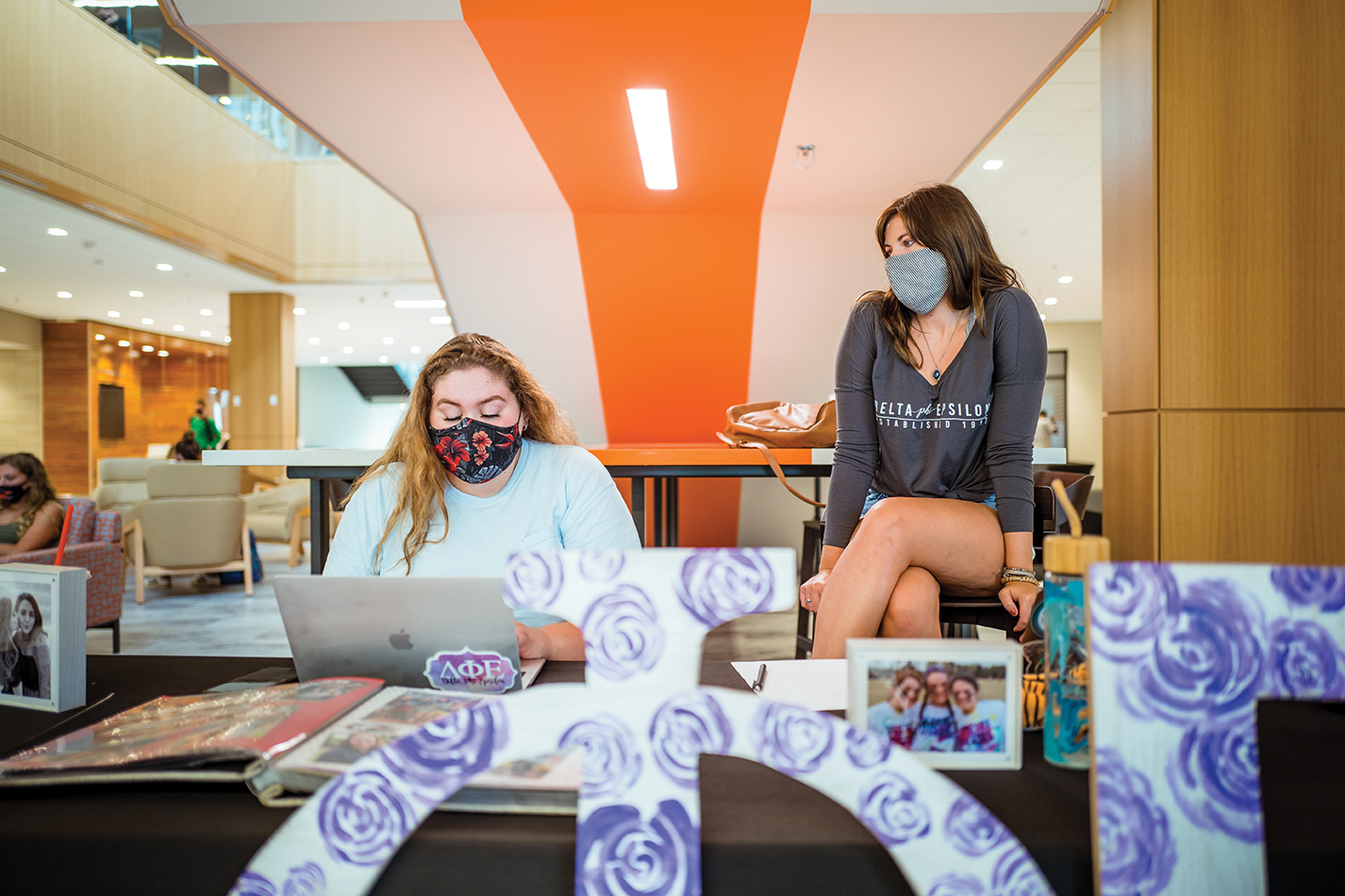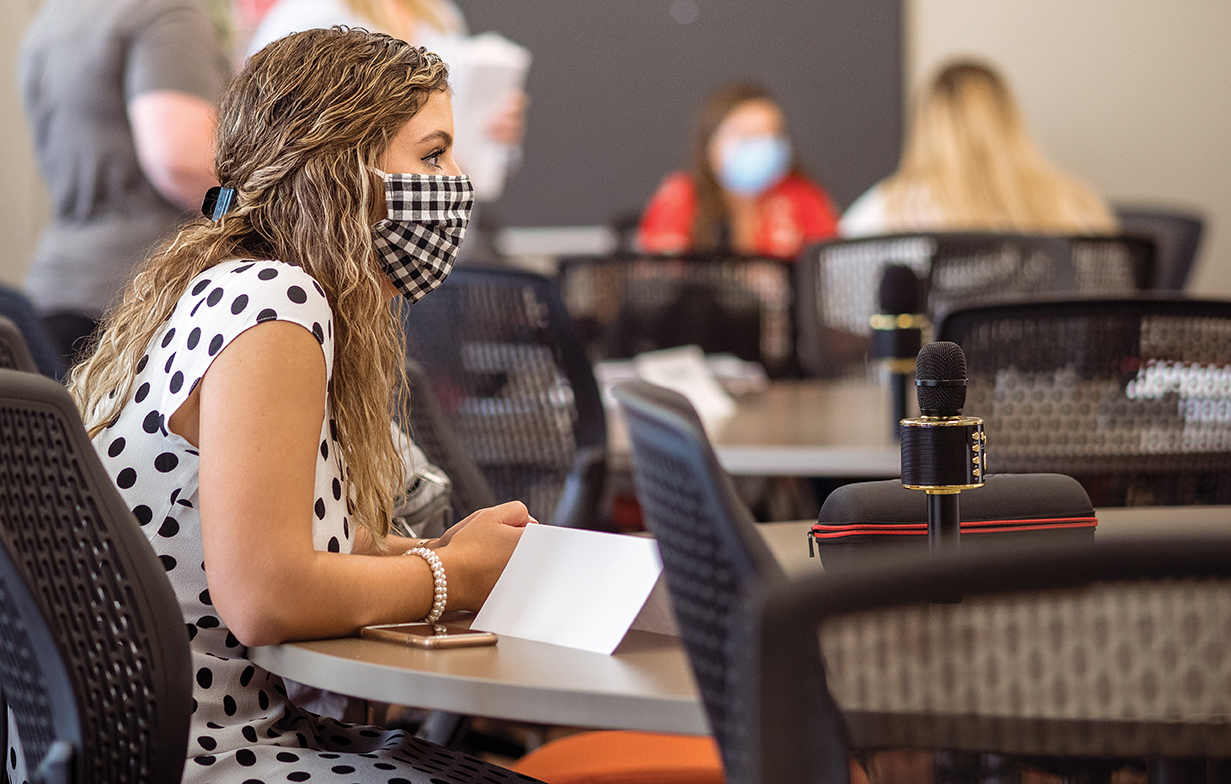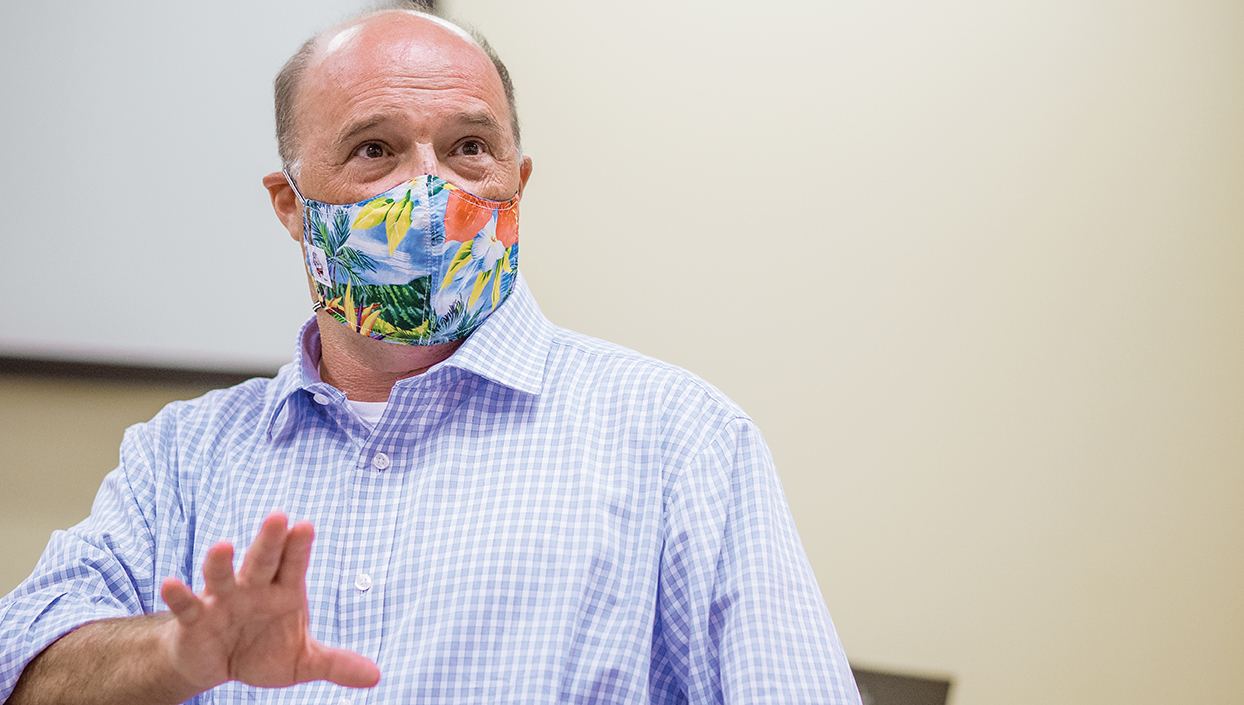Editor’s Note: After the publication of this article, Campbell University announced a two-week “pause” in on-campus, in-person learning for undergraduates in early October after a spike in positive COVID-19 cases. Classes resumed on Oct. 12 after a sharp drop in cases during the pause. As of Oct. 12, Campbell University was on schedule to finish the fall semester with face-to-face instruction.
Students returned to Buies Creek in August for face-to-face instruction for the first time in nearly six months. While the surroundings remain the same, college is a different experience during a global pandemic.
By Kate Stoneburner | Photos by Ben Brown
The start of fall classes at Campbell University on Aug. 19 brought excitement — and many changes from previous semesters — to main campus.
Students now follow the Ws: wearing face masks, waiting six feet apart, and washing hands often.
Classes are a mix of in-person and online to help de-densify campus. Hallways have been converted to one-way corridors and buildings have specified entrance and exit doors to reduce points of contact. Hand sanitizer stations have sprung up across campus, and a temperature reader helps students monitor their wellness. Staff have ramped up cleaning, Plexiglass barriers have been installed in food service areas and many spaces are reduced to 50 percent capacity.
These measures, and especially the decision to provide on-campus students with private accommodations in residence halls, earned Campbell University high marks in a Johns Hopkins Bloomberg School of Public Health assessment, which graded the University “well-prepared” for a return this fall— an accomplishment met with some skepticism as some universities scrambled to make plans for the fall, and others’ best-laid coronavirus plans unraveled after a week of classes.
A reserve of empty rooms gives Campbell’s small, rural campus a place to quarantine students and depopulate campus should an outbreak occur. Campbell is also uniquely situated among other schools in that its health clinic has the ability to do COVID-19 tests on campus. Since March, the clinic has performed 1,000 tests and had 20 positive cases, 17 of which were asymptomatic. With campus reopening, the clinic has ordered 10,000 new test kits and 11 rapid testing machines, which can deliver results in 15 minutes.
The plans to stock up on tests, as well as the proposal and implementation of all safety measures, was the work of the Campbell University Task Force, which had met (and still meets) multiple times each week to carefully consider reopening since March. The task force tracks metrics such as local and campus case-incidence data, testing availability, cleaning and sanitation supplies, availability of masks and personal protective equipment, facilities available for quarantine, contact tracing, on-campus and off-campus exposure and more.

While not all metrics will be made public, a coronavirus data dashboard currently allows media outlets and the campus community see the number of current cases and their status as a residential or off-campus dweller. So far so good — through Sept. 4, 11 positive tests in total have made their way onto the dashboard, two of which were students in residential areas.
The task force and its subcommittees include faculty and staff members from Student Life, Spiritual Life, Health Sciences and Accounting. Mental Health and Substance Abuse Specialist Victoria Weaver served on the Residence Life and Dining Committee, which made decisions around restrictions and safety precautions for residential students including the new single room and restricted visitation policies.
Her own department has made changes to expand their virtual services, but she admitted the transition has been challenging.
“Therapy is about establishing a connection between therapist and client,” Weaver said. “The ability to communicate with body language, facial expressions and tone of voice are vital pieces of the therapeutic process.”
Now, that process is marked by masks and Plexiglass screens or computer screens between therapists and students. Weaver feels for the students who are experiencing what she considers some of the most exciting and enjoyable years of life with so many limitations. But the counseling center is ready to be of service in any way that it can to meet the needs of the Campbell community.
“I don’t know that there are really any right answers.” said Weaver. “What I do know is that the counseling center is ready to be of service, in any way that best meets the needs of our students and Campbell community.”

Hope for the best, prepare for the worst
Among faculty and staff, the response to Campbell’s reopening plans has been one of cautious optimism. Although the recent move to virtual learning by larger schools in the state has raised concerns, Campbell’s smaller population — and smaller party scene culture — may help curb the spread.
“In my opinion on my experience being here, Campbell University is not what I would consider a party school,” Vice President for Advancement Britt Davis said in late August. North Carolina State University and the University of North Carolina-Chapel Hill abruptly moved to online learning mere days into the semester, citing off-campus gatherings, particularly in fraternity and sorority sectors, as responsible for a significant number of infections.
“Are kids going to be kids at a certain level? Of course they are.” Davis said. “I can’t deny it and I don’t think any other school can deny that to a certain level. In general, in my observations, it’s a calmer and a more in-control experience here at Campbell. ”
“I think it’s obvious that students are for the most part really trying to follow the rules when they’re on campus, but we all know that COVID is hard to control even if they do,” added Steve Bahnaman, librarian at Wiggins Memorial Library.
In the early days of a semester, the library is typically only populated with a few undergrads, mainly health science students who have exams sooner than others. Bahnaman isn’t sure what will happen when library crowds increase, as they usually do through September. The new student union may change the game because students no longer need to rely on library space for between-class downtime.
“I feel for the teachers that have to deal with many students a day and teach with a mask on for four hours at a time,” Bahnaman said as he approached his first in-class library session of the semester. “I’ve got it a lot easier than they have.”

Many of those professors handling multiple classes a day are happy to be back in the classroom, regardless of the challenges. Meredith Williams, professor of math, said she feels lucky that her classes are small enough to meet in person, even with reduced room capacities. She hopes that her face-to-face class times are deemed safe enough to continue while she uses her downtime to master the technological component of recording her lectures live — a new and occasionally frustrating process.
“Recording a lecture live through Blackboard as I teach is completely different from what I was doing from home in the spring, so it feels like starting completely over in some ways. I’m not in a situation where I absolutely have to record lectures right now, so I’m thankful to have some time to figure things out.”
In the Communication Studies department, instructor Brian Bowman told several students in the first week how glad he was to see them in person.
“They bring so much energy to campus,” Bowman said. “While my preference is the physical classroom setting and the dialogue it promotes, each faculty member recognizes that we have to be ready to adapt quickly if things go south. Mentally, it’s challenging.”
Professor Shahriar Mostashari of the School of Business concurred. “I am hoping for the best, prepared for the worst, and unsurprised by anything in between,” he said.
Both Mostashari and Bowman reported that every one of their students followed the face covering policy, and had made them proud in the first week of the semester.
“I’m grateful to see everyone taking the virus seriously,” Bowman said. “At some point, I hope we’ll forget what we’re wearing so we can focus on content. We’re not there yet, but we’ll keep going.”
Professors may be optimistic, but students cited several policies as cause for concern, particularly mask exemptions made for athletes in training. Watching other universities go virtual after outbreaks could not be contained only days into the return to campus had some students questioning the wisdom of attempting a return at all.
“It feels like misguided principles geared toward a good public perception,” said senior Hunter Griffis. “Money is prioritized over safety.”
Other students feel that the preventative measures policies are sound, but that certain metrics, such as wellness checks conducted by residence hall staff, were crossing a privacy line. “Most of them are solid, but some of the consequences are over the top,” said a student polled on Instagram. “The college is full of low risk, competent adults,” said another. “No need to be so restricting.”
Most, it seems, have accepted the risks in the knowledge that the University is taking precautions, and are pleased with the new rules and regulations for the safety of students and staff.
“I am thankful for all of those who have been mindful of the new COVID-19 guidelines,” said Lauren McNamara-Clement, a senior studying social work. “It makes being on campus enjoyable when you see people consciously putting on their masks as they enter a building and remaining six feet apart when standing near each other.”
McNamara-Clement is hopeful that if students continue to follow guidelines to the best of their ability and campus is kept clean, she and her classmates will be able to stay on campus. That hope is evident on main campus, where students have co-authored and signed a Promise to Care, stating their intent to follow guidelines strictly, show one another compassion, balance personal freedom and safety procedures fairly, and use the uncertain and unusual campus experience as an opportunity to show the love of Christ to their community.
“I hope for a campus experience without Covid-19,” reads the pledge, “but I will do my best to embrace what this new college experience will bring and will work with others to promote the well-being of my community. During this time, I will act with moral courage, social sensitivity and ethical responsibility in ways that demonstrate the love of Christ in my community.”
— story originally published Sept. 23, 2020


